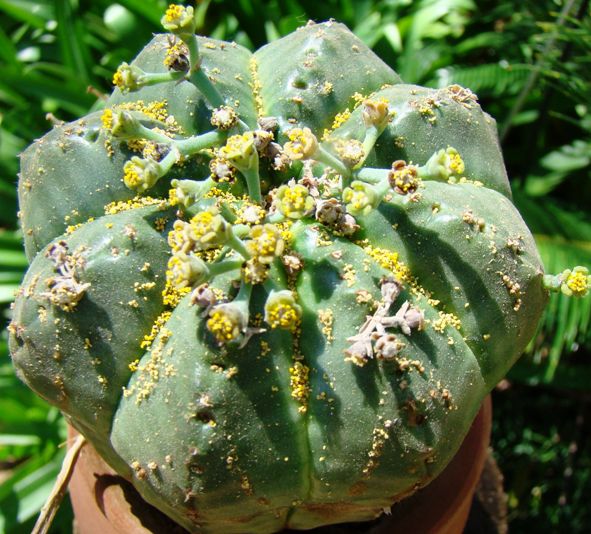|
Botanical name |
Euphorbia meloformis |
|
Other names |
Melon spurge; bobbejaankos (Afrikaans, although this name is also used for other plants) |
|
Family |
Euphorbiaceae |
|
Dimensions |
A dwarf succulent perennial; melon or apple shaped, up to 12 cm in diameter, although the variety that occurs near Peddie may be 20 cm in height and in diameter |
|
Description of stem |
Single stem, sometimes branched at the base; green, rounded ribs, usually 8 in number, sometimes with curved green-shaded or red-brown cross-bands; the bigger form may have up to 14 ribs and a distinctive, grey-green colour; the surface may be smooth or wrinkled in several ways; a vertical row of markings occur on the rib keels where old flower stalks and maybe leaves had fallen |
|
Description of leaves |
Young plants have leaves that sometimes dry out quickly and in other forms last longer on the plant |
|
Description of flowers |
Cream, fleshy flowers (cyathia) branch from a light green stalk on the keel of the ribs of the plant; the flower stalks are sometimes bent and persistent, giving the plant some protection dioecious (male and female flowers on separate plants), although male flowers occur sometimes on female flowers and vice versa; much yellow pollen noted on a flowering male plant; flowers late summer through autumn |
|
Desciption of seed/fruit |
|
|
Description of roots |
Thick taproot |
|
Variation |
Form variations between the three different areas in which these plants occur as well as within the sub-groups, i.e. between individual plants; related to Euphorbia valida |
|
Propagation and cultivation |
Propagated from seed, also can be divided when making offsets at the base; to be planted in sunny positions, in well-drained soil and should receive limited watering |
|
Tolerances |
Drought resistant |
|
Uses |
Common in cultivation as a garden plant, on rockeries and in xeriscaping, also as a container and indoor plant |
|
Ecological rarity |
Occurring in three limited areas, may be decreasing and thus threatened due to illegal plant collection |
|
Pests and diseases |
Gets scale |
|
Other |
This plant was first described in the year of the French Revolution by William Aiton, the gardener of King George III of England, 15 years after the plant was first brought to England from South Africa in 1774 by Francis Masson; this plant is poisonous |
|
Location |
Coastal areas in open grassland |
|
Distribution (SA provinces) |
|
|
Country |
|
|
|
Info: Rikus van Veldhuisen of “u4ba” www.euphorbia.eu |



